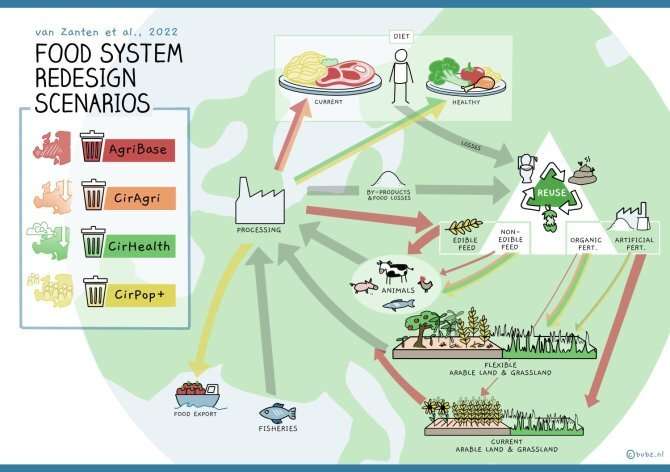This article has been reviewed according to Science X's editorial process and policies. Editors have highlighted the following attributes while ensuring the content's credibility:
fact-checked
peer-reviewed publication
trusted source
proofread
Study outlines scenarios leading toward a circular food system

The EU wants to make the transition to a circular food system, where waste is minimized, waste products are recycled and our impact on the planet is reduced. But what will we eat in the circular food system? What kinds of animals will we keep? And what crops will we grow?
An international group of researchers led by Hannah van Zanten (Wageningen University & Research) has outlined the opportunities for the EU & the UK (EU27+UK) in four scenarios, starting with the current system and culminating in a fully circular food system. Their findings were published in Nature Food on April 17.
The hard figures reveal that there are huge gains to be made if we switch to a circular food system, and the long-running study reached some striking conclusions. For example, the researchers demonstrate that as much as 71% less agricultural land would be needed in a fully circular agriculture system. A 29% per capita reduction in greenhouse gases is also feasible, even while still producing enough food for a healthy diet for all.
Circularity requires a food systems approach
"The figures reveal that a circular food system has huge potential benefits for both our own health and the health of our planet," says Hannah van Zanten.
"There are many uncertainties affecting the food system, such as the war in Ukraine. There will only be more such uncertainties in the future, in part due to climate change and the continually expanding global population. So we need to think carefully about how to redesign our food system. Choices will need to be made which might results in trade-offs, like increasing the global food supply versus making more room for biodiversity. That's why we worked out four scenarios to predict the impact of these choices and reveal the interconnections within the food system."
Four scenarios: from production-driven to fully circular
Four scenarios were developed: a baseline scenario (the current production-driven system) and three scenarios based on circular principles.
In the first of the three circular scenarios (CirAgri), circular principles are applied to the production systems while we continue our current food consumption pattern. In the second scenario (CirHealth), the current consumption pattern is transformed into a healthy dietary pattern (based on the idea that overconsumption is basically a form of waste). Both scenarios reduce the amount of agricultural land required by over two thirds and decrease greenhouse gas emissions by 22% (if we continue our current consumption pattern) and by 29% if we switch to a healthy diet.
In the final scenario (CirPop+), Europe's agricultural land is used to produce as much healthy food as possible. In this scenario, we could feed an additional 767 million people (+149%) outside Europe and so contribute to alleviating the global food crisis. This will, however, require using all of Europe's agricultural land for this purpose. Moreover, total greenhouse emissions increase by 55% in this scenario.
What is required for the transition?
The following conclusions apply to the transition to a circular food system in
the EU27+UK:
- Consumption patterns need to shift to healthier diets. Consumption of animal products must fall by about 50%.
- Livestock will play an important role in the transition, but their numbers must be drastically reduced. Milk and fish will remain relatively important, while beef cattle and pigs will virtually disappear.
- Fewer cereals and fewer fodder crops will be grown, but relatively higher volumes of other crops such as soybeans will need to be produced.
- The current crop rotation system diminishes the potential of the circular system. Completely avoiding feed food competition will actually increase the amount of agricultural land required because feed crops can then no longer be used within rotation. One solution could be to increase the proportion of food crops in rotations but this requires deploying new agro-ecological systems and diversification of cropping. Organic and mineral manure will still be needed in circular food systems. The proportion of organic manure could be increased, for example, by making optimal use of human manure.
- The land required for production is reduced, particularly grassland. This could offer opportunities to improve biodiversity in some areas. The transition will require planning and a clear vision for the long term.
"It is important to realize that the system as a whole is interconnected: from production to processing to consumption," says Van Zanten. "Currently, no one feels ownership for the entire food system. A decision about one production system or chain within the food system can have consequences for the rest system. Our model is the first model to look into the circularity of the entire food system in detail. It offers opportunities to redesign the European food system in a way that respects the health of both humans and the planet."
More information: H. H. E. van Zanten et al, Circularity in Europe strengthens the sustainability of the global food system, Nature Food (2023). DOI: 10.1038/s43016-023-00734-9
Journal information: Nature Food
Provided by Wageningen University





















